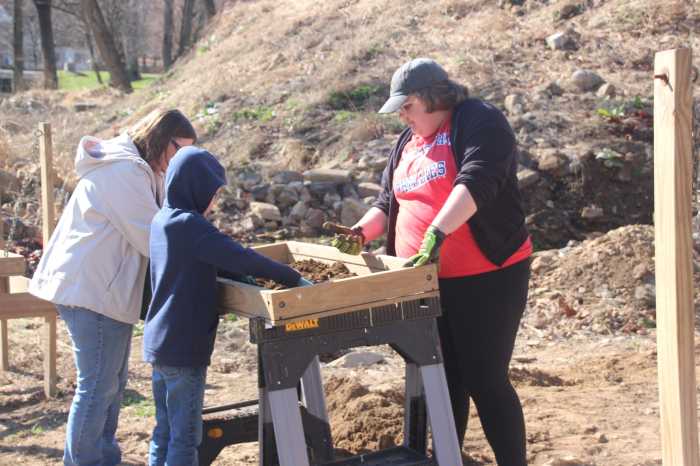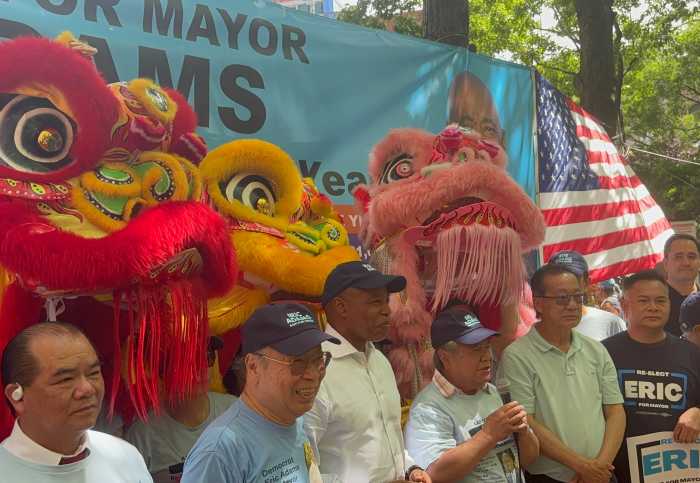 A group of visitors poses for a photo at the top of the steps of the Philadelphia Museum of Art. Credit: Charles Mostoller.
A group of visitors poses for a photo at the top of the steps of the Philadelphia Museum of Art. Credit: Charles Mostoller.
Garrett Brown has an attachment to the steps at the culmination of the Benjamin Franklin Parkway that lead to the front door of the Philadelphia Museum of Art: He formulated the idea of an actor running up those steps, and made the shot of Sylvester Stallone’s famous trek possible with an innovative camera he invented.
And now Brown, 72, thinks he might have a solution to get around a potential alteration of those famous steps.
“I actually have an idea for those fellows and I’m biding my time to pass it on but I think I’d probably better get to it,” Brown said.
A month ago the museum unveiled plans for renovations designed by famous architect Frank Gehry. And the plans included room extensions, infrastructure renovations and, most notably, tearing a hole in the middle of the “Rocky steps” for a skylight.
Last week the state allocated $5 million to the museum to help pay for the multi-million master plan. An exhibition at the museum, which shows off the conceptual models of Gehry’s renovations, runs until Sept. 1.
“I think I have a really good idea that not only preserves the objectives of all of the parties but I think in some respects might be an improvement,” he said. “I admire his plan and I also completely agree with the objections based on the Rocky legacy, so, clearly, there might be another opportunity for another look at that.”
Brown, who invented a device that allowed mobile cameras to shoot smooth shots, admitted that his role in the iconic shot forged a great attachment to the steps.
“And my advice might be suspect on that ground, but I will press on,” he said. “But I think I actually have a notion that might be a good way to do it. I don’t want to bleed it in an interview — I think the parties would feel preempted by that — so I will tell it directly to the parties involved and then I’ll see if they agree.”
Gail Harrity, president and CEO of the Philadelphia Museum of Art, said “What is exciting for us is the public dialogue.”
“What Frank Gehry has presented is two options, one of which envisions the stairs unchanged and one of which introduces new concept,” she said. “I think it works well on both options.”
Harrity added that Gehry was careful to keep in mind that people still would want to climb the stairs, which is why it leaves room on both sides of the proposed skylight.
“I think what’s important to note as people debate this is that we welcome the discussion and that both options are viable and we’re eager to hear the pubic’s thoughts,” she said.
Norman Keyes, museum spokesman, said it’s important to note that the recently awarded state grant will go toward the first phase of construction and not the phase that would include the renovation of the steps, which is still “10 years or more down the line,” he said.
Regarding the grant, Harrity said “A lot of the interior infrastructure is now 85 years old.
“We look at our building as a work of art in itself and we want to maintain it in good order for the present, but for future generations,” she said.
The Steadicam
 Garrett Brown, inventor of the SteadiCam, pictured here with his first model. Credit: GarrettCam.com.
Garrett Brown, inventor of the SteadiCam, pictured here with his first model. Credit: GarrettCam.com.
Brown taught himself filmmaking in the Free Library of Philadelphia reading manuals from the 1940s.
In a barn he housed his 15-pound camera on a large dolly that rolled on tracks because “back in that era you had to be on wheels to have a smooth shot.”
After a few years of working through it, Brown developed a vest that he attached to his camera. The combination allowed the cameraman freedom to move the camera without sacrificing a smooth shot.
He and his then girlfriend — now-wife, Ellen — ran all over Philly shooting “impossible” shots, including a run up the Art Museum steps, and sent a reel around Hollywood to illustrate the possibilities of his invention.
John Avildsen, who would go on to win the Academy Award for Best Director for “Rocky,” saw the demos, found Brown and asked, “Where are those steps and how did you do that?”
“And a few months later I was chasing Stallone up those steps,” he said, “But it was Avildsen and/or Stallone that had the concept for some kind of culminating, athletic thing to pay off the fact that he was finally in shape. And the Art Museum stairs were very serendipitous in that respect, you know. Wonderful icon, great look, something that he could attempt unsuccessfully earlier and then triumph.”
While the revolutionary camera’s first shots were of his better half prancing around Philadelphia, Brown didn’t debut the camera professionally on the “Rocky” set.
Brown, a Haverford High School graduate who lives in Philadelphia, first used the camera on the film “Bound for Glory,” which won the Academy Award for best cinematography the same year “Rocky” won the Oscar for Best Picture.
Brown today owns more than 50 patents associated with that first invention, which includes cameras used in the Olympics and NFL games, among others.
Regarding the rumors that Joe Frazier originally ran up the Art Museum steps and Brown took inspiration from there, Brown said, “Never heard of it and we photographed him and there was never any clue about that, so I don’t know if that’s true or not.”
The people
 Stacey Deng and Kyle Pressley. Credit: Charles Mostoller.
Stacey Deng and Kyle Pressley. Credit: Charles Mostoller.
Running couple Stacey Deng, from the Northeast, and Kyle Pressley, from Germantown, said they visit the steps every other weekend.
Pressley: “Can’t do that, that’s not possible. It’s a landmark. Just like I feel like the statue should actually be right where the footsteps are (at the top of the steps). I know the Fairmount Park Commission said they don’t feel like it’s a piece of art and that’s why they don’t want to put it there, but it is. Everybody that comes to the city, they want to come to the Rocky statue, that’s part of cinema, and cinema is art. So, no, it’s not just steps.”
Deng: “There’s a lot of historical value in it … and you have to be from Philadelphia to really understand and feel how we feel.”
 Rich Harkins, of Center City. Credit: Charles Mostoller.
Rich Harkins, of Center City. Credit: Charles Mostoller.
Rich Harkins, of Center City, was waiting in line Sunday to visit the museum.
“I think it’s OK. This is all wonderful, but if you add something a little more modern, you look at it differently, you know?”
‘Camp Invention’
Last week Brown spoke at Peirce Middle School in West Chester for “Camp Invention.”
He visited the students at the national summer camp, which teaches STEM skills, to try and inspire them to pursue their curiosity.
Brown, a member of the National Inventors Hall of Fame, spoke to five classes ranging from grades first through sixth.
He said he likes helping to push children toward ingenuity and inventiveness.
“It reminds kids that you can get something you want, that you identify that’s missing, only by basically inventing it or waiting for somebody else to,” he said.
For example.
“A kid could have invented roller blades, for example,” he said, “bolt some wheels onto a boot. The trick is to figure out something that’s missing.”
Follow Tommy Rowan on Twitter: @tommyrowan






























